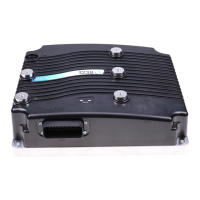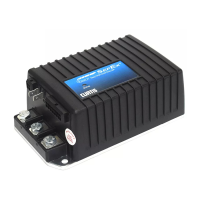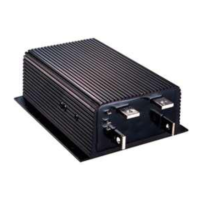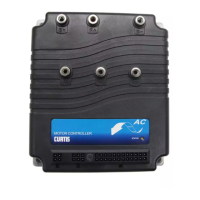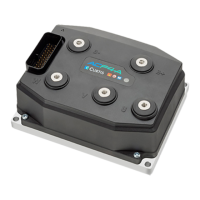6 — COMMISSIONING
Curtis AC F4-A Motor Controller – August 2020 Return to TOC
pg. 136
the opposite of these parameters’ default settings. e broken wire protection is by the controller
sensing the current ow from the pot wiper input (pin 16) through the potentiometer and into I/O
Ground (pin 7). If either connection opens, it triggers the rottle Input fault (ash code 4-2).
3-Wire or 2-Wire throttle parameter setup
Wire the throttle corresponding by type as illustrated in Figures 6, 25 or 26. For potentiometer
throttles, the potentiometer percentage (rottle Input) variable represents the throttle position as a
percentage of full throttle (100%). For throttle assemblies with validation switches or similar signals,
wire and program the validation signal(s) as per their type using the controller’s available switch or
analog inputs. Reference Figure 6 and Tables 5 and 6 for these available switch and analog inputs.
Be sure to include these additional signals in a VCL program as the means to integrate such throttle
validation signals into the controller application.
Note: when selecting a resistive throttle, the monitor item Analog 1 (analog_input_volts_1) reading at
pin 16 relates to the assigned potentiometer value and resistive validation, and as such, the indicated
voltage has no relevance to the throttle’s setup or diagnostics. e analog voltage monitor value will
cycle with the internal validation. Do not use the analog voltage for control purposes.
Voltage Throttle
When using a voltage source as a throttle, it is the responsibility of the OEM to provide appropriate
throttle fault detection. For ground-referenced 0–5 V throttles, the controller will detect open breaks
(i.e., wire disconnect) in the Analog1 input (analog_input_volts_1), but it cannot provide full throttle
fault (valid throttle signal) protection. For tiller-handles providing a voltage signal, throttle validation
is the responsibility of the vehicle OEM. For tiller-handles providing a CANbus throttle command (i.e.,
VCL_rottle), throttle validation is the responsibility of the vehicle OEM. It is recommended that
throttle validation be handled within the tiller-handle itself (i.e., as throttle assemblies oer).
To use a current source as a voltage throttle, add a resistor in parallel to the circuit to convert the
current source value to a voltage. Size the resistor to provide a 0–5 V or 0–10 V signal variation over
the full current range. It is the responsibility of the OEM to provide appropriate throttle fault detection
in these throttles as well. Reference the diagram in Figure 28, below.
I/O Ground (Pin 7)
Pot 1 Wiper input (Pin 16)
5kΩ–0
FASTER
Figure 26
Wiring for 2-Wire
Potentiometer throttles
